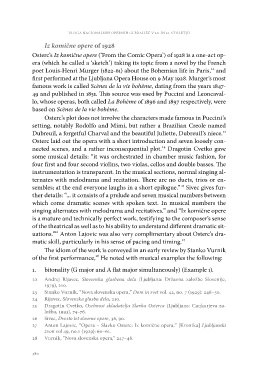Page 382 - Weiss, Jernej, ur. 2019. Vloga nacionalnih opernih gledališč v 20. in 21. stoletju - The Role of National Opera Houses in the 20th and 21st Centuries. Koper/Ljubljana: Založba Univerze na Primorskem in Festival Ljubljana. Studia musicologica Labacensia, 3
P. 382
vloga nacionalnih opernih gledališč v 20. in 21. stoletju
Iz komične opere of 1928
Osterc’s Iz komične opere (‘From the Comic Opera’) of 1928 is a one-act op-
era (which he called a ‘sketch’) taking its topic from a novel by the French
poet Louis-Henri Murger (1822-61) about the Bohemian life in Paris,22 and
first performed at the Ljubljana Opera House on 9 May 1928. Murger’s most
famous work is called Scènes de la vie bohème, dating from the years 1847-
49 and published in 1851. This source was used by Puccini and Leoncaval-
lo, whose operas, both called La Bohème of 1896 and 1897 respectively, were
based on Scènes de la vie bohème.
Osterc’s plot does not involve the characters made famous in Puccini’s
setting, notably Rodolfo and Mimi, but rather a Brazilian Creole named
Dubreuil, a forgetful Charval and the beautiful Juliette, Dubreuil’s niece.23
Osterc laid out the opera with a short introduction and seven loosely con-
nected scenes, and a rather inconsequential plot.24 Dragotin Cvetko gave
some musical details: “it was orchestrated in chamber music fashion, for
four first and four second violins, two violas, cellos and double basses. The
instrumentation is transparent. In the musical sections, normal singing al-
ternates with melodrama and recitation. There are no duets, trios or en-
sembles; at the end everyone laughs in a short epilogue.” 25 Sivec gives fur-
ther details: “... it consists of a prelude and seven musical numbers between
which come dramatic scenes with spoken text. In musical numbers the
singing alternates with melodrama and recitatives.” and “Iz komične opere
is a mature and technically perfect work, testifying to the composer’s sense
of the theatrical as well as to his ability to understand different dramatic sit-
uations.”26 Anton Lajovic was also very complimentary about Osterc’s dra-
matic skill, particularly in his sense of pacing and timing.27
The idiom of the work is conveyed in an early review by Stanko Vurnik
of the first performance,28 He noted with musical examples the following:
1. bitonality (G major and A flat major simultaneously) (Example 1).
22 Andrej Rijavec, Slovenska glasbena dela (Ljubljana: Državna založbe Slovenije,
1979), 210.
23 Stanko Vurnik, “Nova slovenska opera,” Dom in svet vol. 42, no. 7 (1929): 246–50.
24 Rijavec, Slovenska glasba dela, 210.
25 Dragotin Cvetko, Osebnost skladatelja Slavka Osterca (Ljubljana: Cankarjeva za-
ložba, 1993), 74–76.
26 Sivec, Dvesto let slovene opere, 36, 90.
27 Anton Lajovic, “Opera – Slavko Osterc: Iz komične opera,” [Kronika] Ljubljanski
zvon vol 49, no.1 (1929): 60–61.
28 Vurnik, “Nova slovenska opera,” 247–48.
380
Iz komične opere of 1928
Osterc’s Iz komične opere (‘From the Comic Opera’) of 1928 is a one-act op-
era (which he called a ‘sketch’) taking its topic from a novel by the French
poet Louis-Henri Murger (1822-61) about the Bohemian life in Paris,22 and
first performed at the Ljubljana Opera House on 9 May 1928. Murger’s most
famous work is called Scènes de la vie bohème, dating from the years 1847-
49 and published in 1851. This source was used by Puccini and Leoncaval-
lo, whose operas, both called La Bohème of 1896 and 1897 respectively, were
based on Scènes de la vie bohème.
Osterc’s plot does not involve the characters made famous in Puccini’s
setting, notably Rodolfo and Mimi, but rather a Brazilian Creole named
Dubreuil, a forgetful Charval and the beautiful Juliette, Dubreuil’s niece.23
Osterc laid out the opera with a short introduction and seven loosely con-
nected scenes, and a rather inconsequential plot.24 Dragotin Cvetko gave
some musical details: “it was orchestrated in chamber music fashion, for
four first and four second violins, two violas, cellos and double basses. The
instrumentation is transparent. In the musical sections, normal singing al-
ternates with melodrama and recitation. There are no duets, trios or en-
sembles; at the end everyone laughs in a short epilogue.” 25 Sivec gives fur-
ther details: “... it consists of a prelude and seven musical numbers between
which come dramatic scenes with spoken text. In musical numbers the
singing alternates with melodrama and recitatives.” and “Iz komične opere
is a mature and technically perfect work, testifying to the composer’s sense
of the theatrical as well as to his ability to understand different dramatic sit-
uations.”26 Anton Lajovic was also very complimentary about Osterc’s dra-
matic skill, particularly in his sense of pacing and timing.27
The idiom of the work is conveyed in an early review by Stanko Vurnik
of the first performance,28 He noted with musical examples the following:
1. bitonality (G major and A flat major simultaneously) (Example 1).
22 Andrej Rijavec, Slovenska glasbena dela (Ljubljana: Državna založbe Slovenije,
1979), 210.
23 Stanko Vurnik, “Nova slovenska opera,” Dom in svet vol. 42, no. 7 (1929): 246–50.
24 Rijavec, Slovenska glasba dela, 210.
25 Dragotin Cvetko, Osebnost skladatelja Slavka Osterca (Ljubljana: Cankarjeva za-
ložba, 1993), 74–76.
26 Sivec, Dvesto let slovene opere, 36, 90.
27 Anton Lajovic, “Opera – Slavko Osterc: Iz komične opera,” [Kronika] Ljubljanski
zvon vol 49, no.1 (1929): 60–61.
28 Vurnik, “Nova slovenska opera,” 247–48.
380


